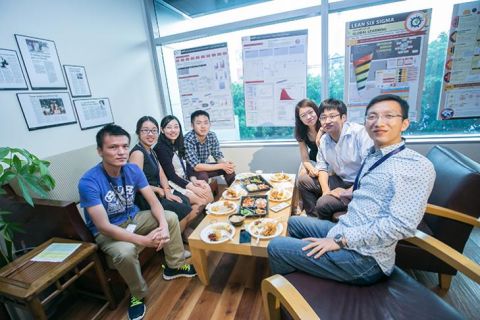
Photo Credit: Tang Yew Chung
At a recent talk organised by SMU Li Ka Shing Library, Gartner’s Bhavish Sood discussed innovations in the field of business intelligence.
By Tang Yew Chung
SMU Office of Research – Business intelligence and analytics will continue to be the top technology spending priority for companies, according to information technology research and advisory firm Gartner.
This was a key insight shared by Bhavish Sood, research director at Gartner, during a talk organised by the Singapore Management University (SMU) Li Ka Shing Library on 23 July 2015.
Business Intelligence (BI) is an umbrella term that describes how companies derive meaningful insights from raw data. BI encompasses software, infrastructure, policies and procedures that can help companies make smarter, data-driven business decisions.
One crucial component of BI is analytics. While traditional BI has focused on measuring and reporting past performance, answering questions such as “what happened?”, “how many?”, “how often?” and “where?”, business analytics seeks to anticipate what is ahead, with forward-looking questions such as “what if these trends continue?”, “what will happen next?”, and “what is the best that can happen?”.
The 2015 Gartner CIO Survey
During the talk which was attended by the SMU community, Sood shared his insights on best practices, trends and future opportunities in the business analytics market.
He began by presenting some findings from the 2015 Gartner CIO Survey, which included responses collected from more than 2,800 chief information officers (CIO) of companies across 84 countries, representing all major industries worldwide and approximately US$12.1 trillion in revenue/public sector budgets and US$397 billion in IT spending.
“We asked [the CIOs] to prioritise where they are going to spend their budget, what is their wish list, and we see that BI and analytics continue to be the top priority in 2015, both in the Asia Pacific region and in the rest of the world,” Sood said.
The survey, he noted, also showed that about 80 percent of the companies were already carrying out passive analysis of data, an activity associated with traditional BI. This was a good sign, he said, because “if you want to do advanced analytics or any predictive analysis, as a culture, you first need a lot of data-driven efficiencies, even if it is just doing historical analysis.”
A similar proportion (79 percent) of CIOs surveyed also indicated that they were seeking to move from doing backward-looking reporting to forward-looking predictive analytics. However, Sood warned companies against jumping on the analytics bandwagon if they had no prior experience in BI.
“I have several clients who tell me that they want to do predictive analytics but they had no historical reporting; they haven’t done any sort of BI. You can’t just go from that stage to doing advanced or predictive analytics, no matter what the hype is and no matter what your vendors are telling you,” he cautioned.
In practice, companies need at least several years’ data for model testing and calibration, he said. “If you do not have data for the last five or six years, then it is going to be pretty much impossible for you to do any meaningful prediction.”
Data discovery to experience three times the growth of BI market
Another key trend highlighted during the talk was that data discovery software companies, like Qlik and Tableau, were experiencing much higher growth than traditional BI vendors like SAP, Oracle, IBM and SAS. Data discovery refers to BI architecture aimed at producing interactive reports and with the ability to explore data from multiple sources.
According to Sood, the data discovery segment is expected to grow by 24 percent in 2015, three times the growth rate of the entire BI market. “This [growth] is happening,” Sood said, “because business guys are owning more and more analytics.”
Sood described the three most common complaints business users have regarding their BI software, especially those provided by traditional BI vendors. Firstly, the lack of self-service, which requires IT support every time a report needs to be written; secondly, the length in time it takes to fetch data because software performance is not optimised; and thirdly, the lack of visualisation for complex pattern analysis.
“What Qlik and Tableau have done is that they have focused their product only on these three use cases. They are not building BI infrastructure,” he pointed out.
Although these vendors gain no revenue from selling software to new customers, they rely on annual maintenance fees paid by existing customers, which may range from 15 to 20 percent year on year. Sood said. “That’s where their entire growth is. As a business model, that’s highly lucrative. Most vendors will make upwards of 80 percent net on maintenance support.”
Sood said that it is interesting to see how traditional BI vendors are trying to bring in their own data discovery offerings. “SAP is trying to bring in Lumira as competition, IBM Cognos has Watson, MicroStrategy has Visual Analytics,” he said. “Everybody is trying to bring in their own offerings but these offerings, at the moment, are nowhere even close to what standalone data discovery tools can offer.”
And with growth in the BI market transitioning completely to data discovery, it is only a matter of time before data discovery eclipses data reporting as the focus of BI, he said.
Sood concluded his talk by reiterating that BI will continue to grow because it is a crucial component for companies to gain an information advantage. He expressed confidence that based on market trends, BI vendors will increasingly focus on the Asian market, where he believes significant innovation in the BI field will also emerge.
See More News
Want to see more of SMU Research?
Sign up for Research@SMU e-newslettter to know more about our research and research-related events!
If you would like to remove yourself from all our mailing list, please visit https://eservices.smu.edu.sg/internet/DNC/Default.aspx

